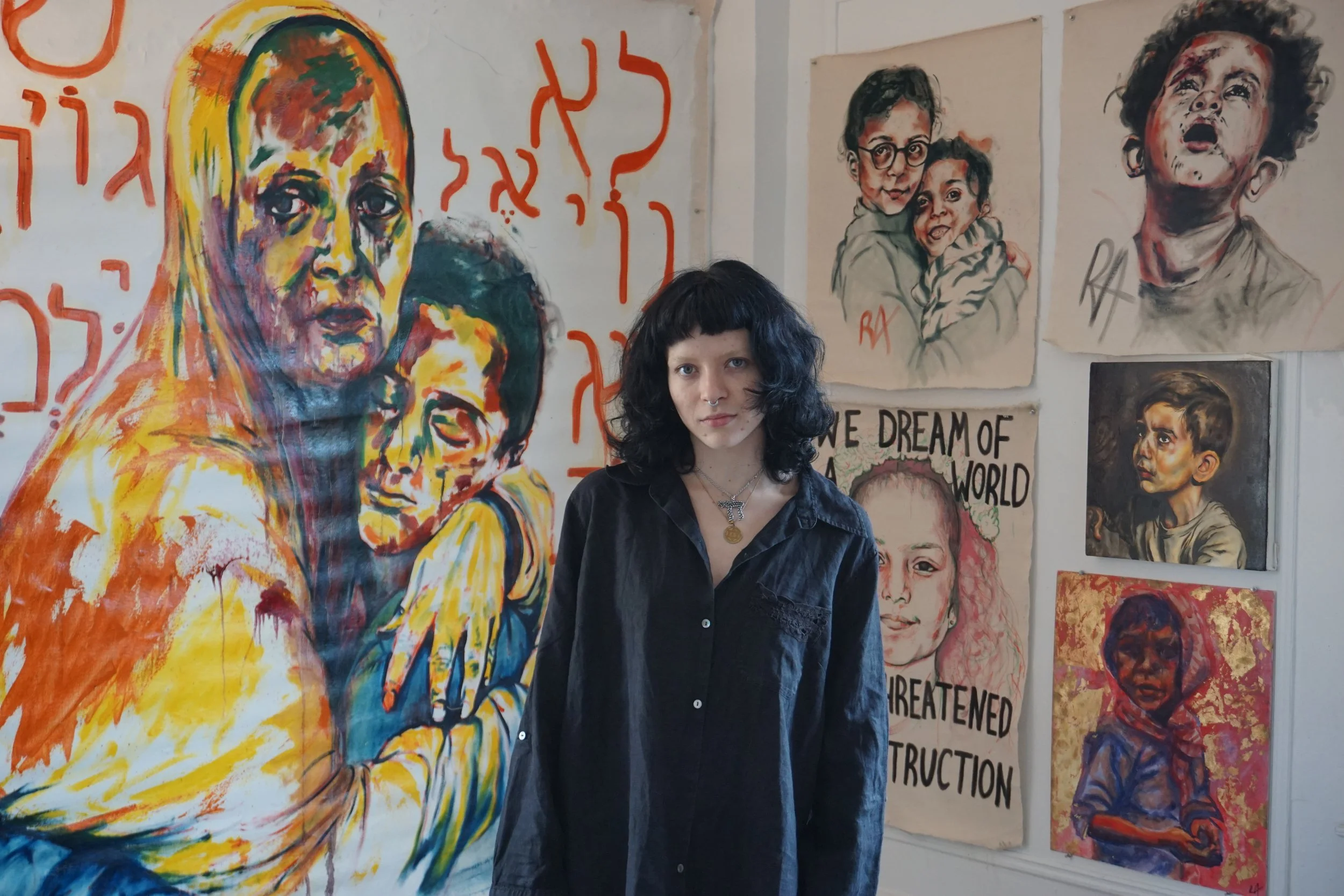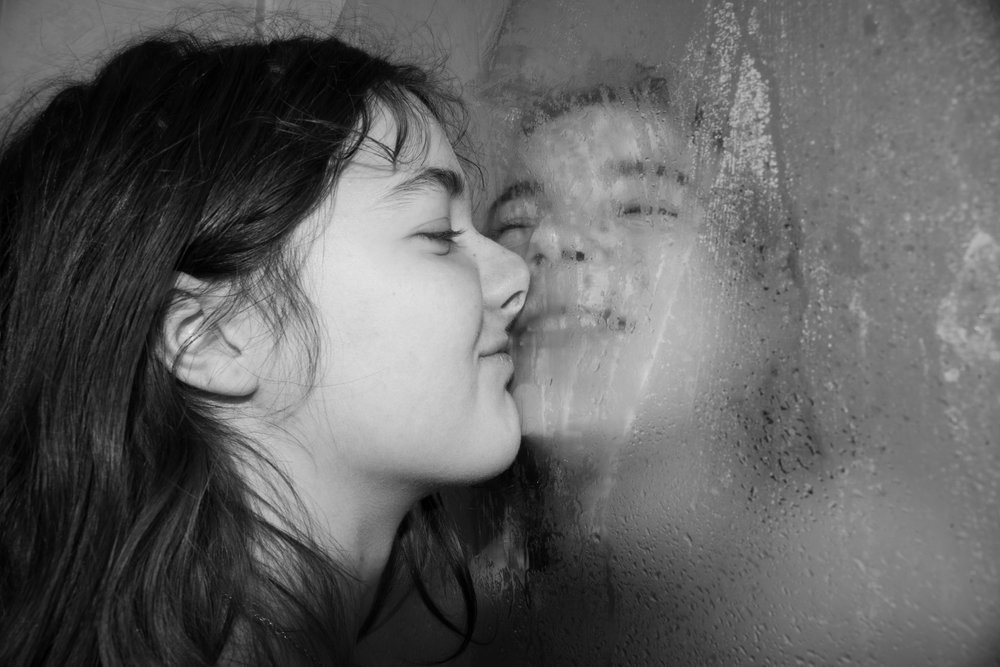Feature by Kate Henry
Photos by Iris Pope
Maya (she/her) is a senior at Columbia College studying Russian Literature (CC ’25). She works in both digital and film to showcase not only her technical skills but also her deep emotional intelligence and connection to her subjects. Her ability to capture the “little details” of someone's character through her photography gives her photos depth and an atmospheric quality. She is curious and excited to keep pushing the boundaries of her photography, always eager to learn more and capture more of her world.
Maya and I agreed to meet at her apartment near campus, and as I walked through the hallway to her door I was anxious to see what would come of the conversation. After conducting some light reconnaissance of her portfolio before the interview, I got the sense that Maya’s view of the world is bold and electrifying. Often working in black and white to amplify the contrast in her images, her style captures animated and thought-provoking moments. I was unsure of the best way to approach asking about a style like hers.
Yet Maya welcomed me in, and as I set up my things, she and her roommate finished cooking their fried eggs for breakfast. Seeing them as they live informally and without preparation was inviting.
A row of various black boots lined the wall, housed under a rack of eclectic jackets. Funky chairs and a coffee table with magazines and newspapers filled the living room, and my eye was immediately drawn to a large sparkly Gustav Klimt painting hanging on the wall that Maya later told me was from HomeGoods. Wine bottles with dainty flowers inside and printed photographs of household items (I think one of them was of the inside of a dishwasher) muddled my preconceived notions of Maya from her work and immediately ignited my curiosity about who she is.
I began by asking her about the beginning of her interest in photography. She replied with a smile that she first started getting into photography when she was very young, about 7, and she and her best friend would pose for the camera and make content about “how to be a fashion model” and what to wear. Perhaps this fueled Maya’s interest in fashion photography because she has since worked as a photography assistant for a Vogue Portugal shoot and has had her work featured in Interview Magazine among other well-known publications. She is also the Editor-at-large for Hoot Magazine, Columbia/Barnard’s fashion magazine.
“I had a lot of really good photography influences in my life, just felt like a natural progression…One of my friends asked me to do a photography job; would take photos for weekly gatherings hosted by the New York chapter of the UN. On my way to that I would take pictures of my friends, and felt this was bringing me so much joy. I just went from there.”
Many of Maya’s photographs capture her friends, and I asked her how she goes about shooting people she knows. She responded that she lets her relationship with her subjects dictate the direction of the shoot. This casual format and spontaneity of the shoots allow the nature of Maya’s relationships to show through. She clearly sees beyond what the camera lens shows. She is able to capture emotions that perhaps people don’t even know they’re expressing, like the subtle nuances of their expressions, quick glances and movements, or even just capturing the emotion behind someone's eyes.
“I'm naturally very good at psychoanalysis, so I want to continue that theme in my work… I'm obsessed with people's, like, tiny details”
When Maya revealed her skills for reading people, I, too, felt analyzed. There were many times throughout the interview that I had to redirect the line of questioning back to her because we would fall into easy conversation and she would begin asking me questions about myself. This speaks to a natural inquisitiveness and interest in uncovering the parts of people below the surface. I immediately thought of one of the first photographs I saw in her portfolio from an Alice in Wonderland-inspired shoot. The model stares directly at the camera, with an ornate, sculptural headdress, and tears streaming down her face. Maya captured the model’s mood so vividly, and even though it’s not a wild facial expression, something in her eyes tells viewers more.
She also works in self-portraiture. “When I am choosing myself [as the subject]” she explained “it's to make a point. It's to say something, to reflect on how I'm feeling. There's the first self-portrait stuff that I really did when I was first starting to get a grasp on what photography really was. That was really powerful, to be in the studio by myself and just pose in front of the camera”
The self-portraiture she engages in seems to serve as a form of introspection, allowing her to explore her feelings and identity. This power is evident in her self-portraiture, which she seldom seems to do. It’s clear that this practice holds significant weight for her, and it adds another layer to her understanding of photography as a medium for both personal expression and capturing the world through her eyes.
Her current project is with darkroom photography, a new medium for her. As a senior herself, she has been capturing her subjects in graduation caps and gowns in various scenes. Her concept aims to highlight the instability of graduation in a society that is increasingly unstable itself. By photographing graduates in unorthodox and imaginative ways, she wants to convey the uncertainty of post-graduate life and the future of the world.
“People didn't really post-grad photos last semester unless you didn't care at all about what was going on. And the ones that were posted were super shiny and really contrasted everything else that was being posted online. So I thought, well, I think that a lot of my friends could not see themselves smiling in front of Columbia in the same pose.”
Thus, the idea to make quasi-grad photos was born. Some images show her friend, dressed in a Columbia-blue gown eating in John Jay, while another shows a graduate in a bathtub. Darkroom is an unfamiliar process for Maya, but she’s excited to work with a photography medium that produces a physical object. There’s a chemistry and materiality to the process that brings a different element to the final photographs.
Maya spoke about the community of artists she is surrounded by at Columbia and in New York in general. She mentioned the underground Russian Queer community (which is perhaps a little less underground now, sorry) and the way she, perhaps subconsciously, represents elements of this community in her work. She spoke about the nonconformist art they create “about extremism, internet culture and smoking weed, and weed addiction and schizophrenia.”
This artist community who inspires and creates alongside Maya was the focus of her exhibition in the very apartment we were in. She hosted an exhibition titled Immediate Art, in which 20 of her friends displayed their work in the empty apartment before Maya and her roommates moved in. Some of the artwork still hung as we spoke, and Maya smiled as she said, ‘I'm just gonna keep your work. Yeah, if you don't want it back, you don't ask for it back, and then I’ll just keep it.”.
Maya sees herself putting on more exhibitions and displaying more of her work too. She will continue to take Photography classes at Columbia, but she sees herself going back to school for Russian Literature as well. Perhaps her experience with fashion photography will open doors, but for right now “[She’s] more interested in reflecting on what's going on around me, and kind of picking up pieces here and there.”








































